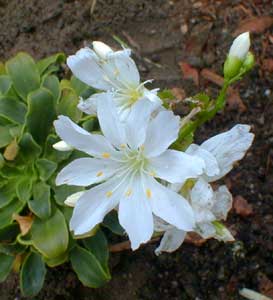 White Cliff Maids; or,
White Cliff Maids; or,
"Alba" Bitterroot
"Tell me, ye Zephyrs! that unfold,
While fluttering o'er this gay Recess,
Pinions that fanned the teeming mould
Of Eden's blissful wilderness,
Did only softly-stealing hours
There close the peaceful lives of flowers?"
-William Wordsworth
(1770-1850)
(1770-1850)
Lewisia cotyledon forma alba is a pure white-flowering lewisia, with the blossoms rather larger than average.
In an ideal year the flowers circling the clump on six-inch stems will be so numerous that the basal leaves are completely hidden. Its first flowers arrive in May & June, with periodic summer rebloom & weakening rebloom well into autumn.
The leaves on average form smaller & denser rosettes than for most L. cotyledon.
"Alba" originated as a wild variant, so it generally grows true from seed, unlike the intraspecies hybrids.
There are white forms of other lewisias as well, including for L. tweedyi, L. rediviva, & L. pygmaea, with Tweedy's White being available for gardens.
L. cotyledon in general wants to be planted between rocks in plenty of sun, so that its leaves but not its roots will be heated. In their native habitat they grow in rocky outcroppings & on canyon walls, hence the common name Cliff Maids. They manage despite these inhospitable & seemingly exposed sites to even so avoid windy locations, often occurring in colonies in cliff depressions or between crags which the harshest winter winds bypass. Such preferences should be kept in mind when finding a suitable location for them in gardens. Well placed, lewisias are long-lived & hardy. Poorly placed, they waste away.
The harshness of their riparian locations & cliff-side habitat is suggestive of how hardy they can be. But bare in mind how in the sorts of harsh locations they self-select in nature, even a heavy rainfall will soon dry out. Thus they are not hardy in well-watered gardens. Brought down from their subalpine heights to sea level gardens, they easily fall prey to root-rot. The main cause of difficulty is overwatering or placement in soil that does not drain instantly. They are also intolerant of alkalinity, & in the wild are not found in limestone environments. So pH neutral to slightly acidic soils are required.
So some gardeners regard them as very tricky to grow, though we've had nothing but good luck with them. Ours do so well because they are planted along stone ledges & rarely watered at all, with plenty of afternoon sun (though some are doing fine in partial shade as nearby shrubs grow larger).
I have laid flattish rocks around & between many of the specimens, & for some of them scattered pea-gravel over the surface, attempting to duplicate what would have been their self-selected environment. In these conditions on sharp-drainage ledges we've found them to be longlived easy plants to grow. They do occasionally have "scruffy" periods of partial die-back of the lowermost leaves, which used to worry me no end, but they always bounce back so I've gotten over worrying about it.
Lewisias though not presently threatened with extinction are listed federally as a "species of concern," & have already vanished from many areas where they were once common. Healthy populations have become dispersed far from one another throughout the Northwest. They should never be collected from the wild, although alas horticultural collecting is second only to habitat loss for these plants, & within national parks, collecting & recreational activity is the number one threat.
The disappearance of lewisias along hiking trails has been well documented, alleged nature-lovers decimating the populations by transferring plants to their backpacks. So if you ever stumble onto one of these villainous people, pick up the nearest handy rock & flatten their noses! Or, at least get a complete discription of the felonious cretins & get on the nearest cell phone so that park rangers can arrest them with the goods still on them.
Cultivated strains are generally intraspecies hybrids, seed-grown by specialty nurseries. These are vastly hardier in the gardens than any plant kidnapped from national parks, & they are not too awfully expensive. So there is no reason other than unmittigated villainy to molest wild populations.
Lewisia cotyledon variant howellii